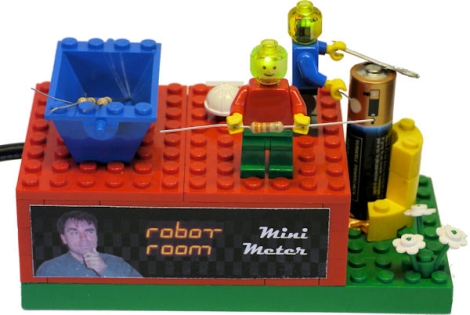
While there’s typically not much room on our work bench for toys, [David] over at Robot Room has put together a pretty cool multimeter for which we would make an exception.
His Lego Minifig multimeter is constructed using mostly standard off-the-shelf Legos, and a pair of Minifigs he modified to suit his needs. Translucent Minifig heads were sourced online to allow the neck-mounted LEDs to shine through, and each of the bodies were drilled out in several places to accommodate the wires he uses to take measurements.
The multimeter will display the resistance of any item from 10 – 10,000,000 Ω, as well as measure the voltage of any battery you can manage to fit under the Minifig’s metal wrench. The multimeter takes measurements using an ATmega168, and relays that data through a serial to USB converter connected to a nearby computer. The computer is host to a .NET application he wrote which displays and speaks both the resistance and voltage values.
Keep reading to see a quick video walkthrough and a demonstration of the multimeter at work.
[youtube=http://www.youtube.com/watch?v=d-Oc3YLc7GM&w=470]















Brilliant project!
I’ve never understood why resistances are color coded. Why the value isn’t clearly written on them like every others components?
I think the troll detector blew up on that one.
@Olivier: when companies started producing resistors probably in the early 20th century, printing technology wasn’t nearly as advanced as today. So for “small” resistors it was much easier to just put a couple of rings of colored ink around them. I’ve seen tube radios from the 1950s and 1960s that had big (2 Watt?) resistors with printed values though, and of course many tiny surface-mount resistors nowadays also have the value printed on them, if they are large enough that a normal person can read them anyway (many aren’t!).
@Jac Goudsmit: thanks a lot for the explanation!
@Jac Goudsmit
Weird, in soviet russia, its was really weird to see resistors *with* color bands, even very very old ones have value printed on them.
Big ones:
http://content.foto.mail.ru/list/miha11/1/i-82.jpg
Small ones:
http://pro-radio.ru/user/uploads/128822.jpg
Markup:
http://www.radiant.su/files/images/cod_1.jpg
Etc:
http://www.erkon-nn.ru/file/r1-43/r1-43.png
Go figure?
http://www.leningrad.su/museum/show_big.php?n=1075
More on that – find a weird cookie in a jar.
Other thing that pisses me off is weird notation of glue logics that most of us familiar with, like 74HC00, in soviet russia that would be K1564LA3, where numbers show the logic family HC, and letters show the function – 00, single glance on the pcb pretty much tells you what is it made of, counters, registers, glue logics…
Really cool, but I’d imagine most of here can look at resistors and read them instantly.
A nicely rounded project, which would be a neat little educational toy for kids interested in electronics.
If it could all be done in hardware that would be even better – I’m sure I’ve seen text to speech chips somewhere. Perhaps use five RGB leds to display the colour stripes and maybe a 16×2 LCD for text output.
I’m a big lego fan, so this caught my eye immediately. Although I find it mildly sacrilegious that you’ve drilled holes in a couple of innocent lego men! :D
Cool.
The build is fantastic and looks great, but I also find it hilarious that he spends half the video trying to convince us that this rig is more convenient than learning resistor codes.
It’s okay, cool projects do not need to fill gaps in the market or have socially redeeming value!
resistor color codes really suck when your color deficient
It’s my understanding that resistors use color bands for value ID so that even after being installed in a board, the value can quickly be read from any angle.
@wosser:
>> Perhaps use five RGB leds to display the colour stripes and maybe a 16×2 LCD for text output.<<
This statement jogged my memory. I'm sure I've seen a project on here within the last year or so that does almost exactly this. It was someone's entry for some contest.
Found it!
http://hackaday.com/2010/01/15/know-your-resistors-tell-the-time/
Ok this project is resistor as a clock. But… There's your light-up resistor! :-)
Completely, unreservedly badass. I love it.
sniff… no code share at all ;<
While I am pretty good at reading values from color codes, there are some that are very difficult to make out. In particular 1/8 watt resistors with tiny bands, very old/dirty/overheated resistors, etc. Even with a loupe (magnifier) it can be hard to tell sometimes. Yeah, a multimeter is just as fast as this “toy”, but not as fun!
@jamieriddles Im god and I took colors from you for all those kittens you drawn
@therian
And what exactly is wrong with drawing kittens?
Lego Bricks, not Legos.
Absolutely love this. To death and skittles.
This is very creative. However if you already know resistor codes I am not sure if it is that helpful.
I want to know the reason of why dont you just use multimeter?